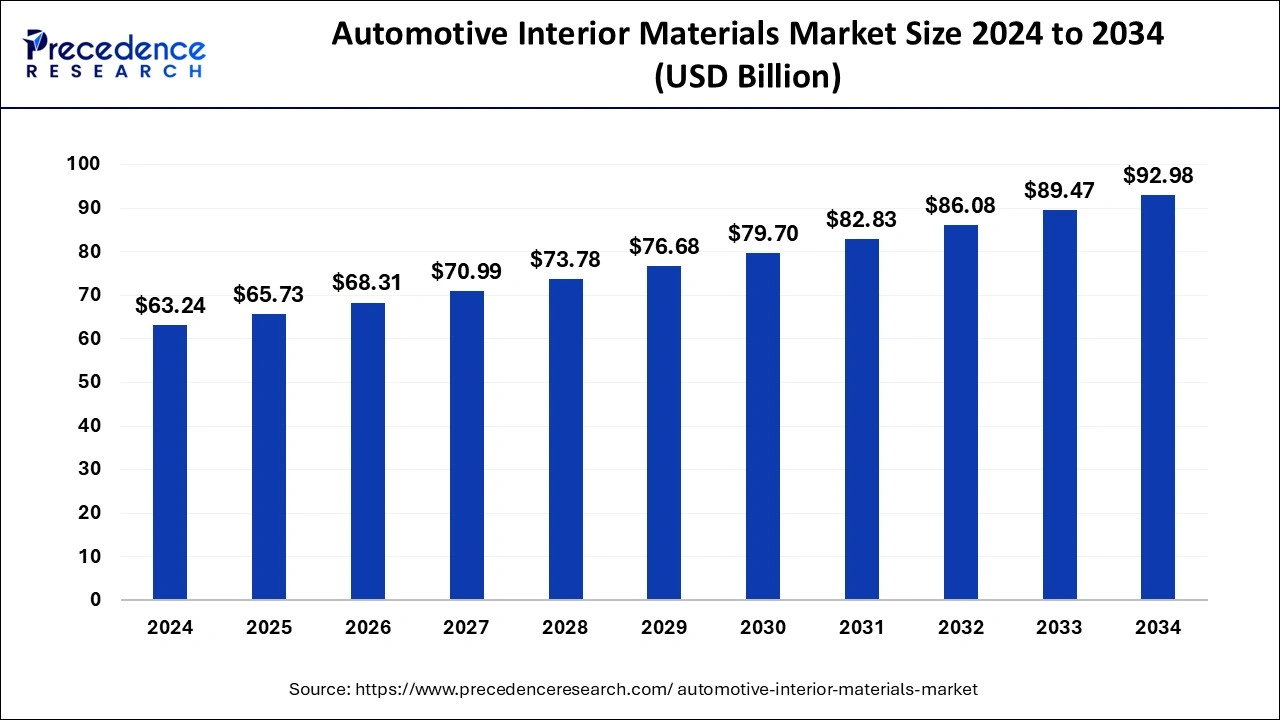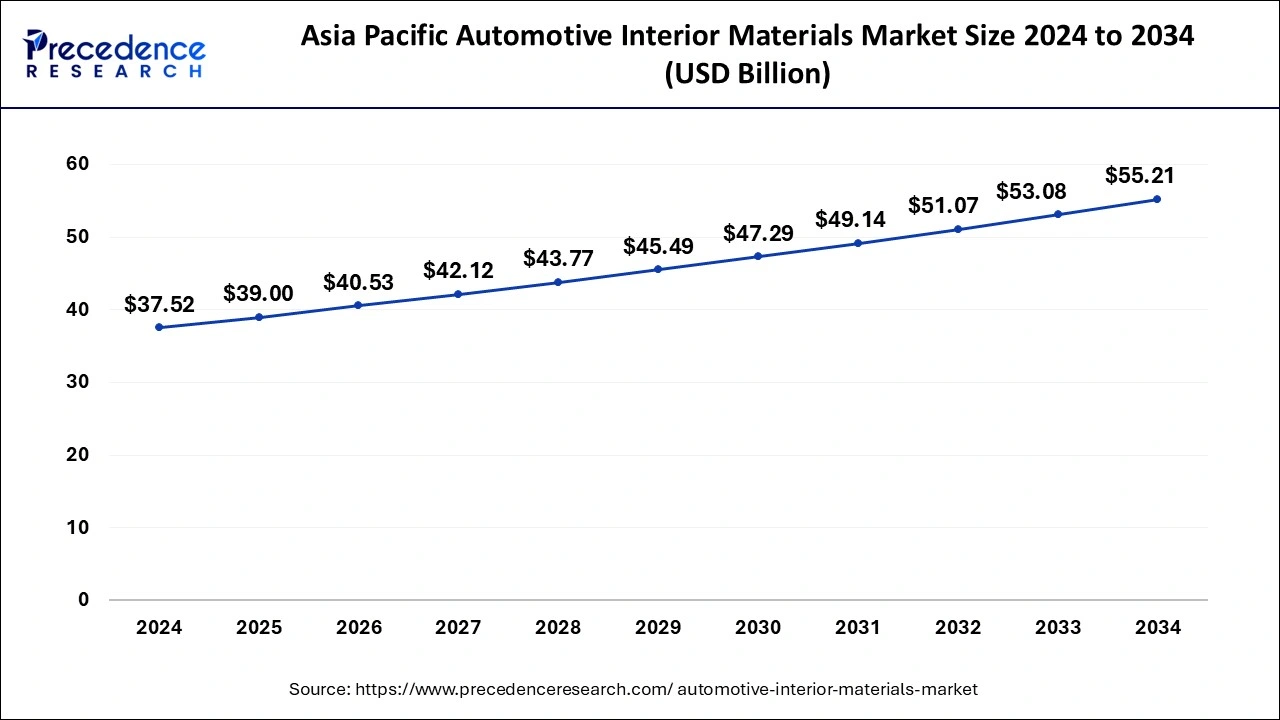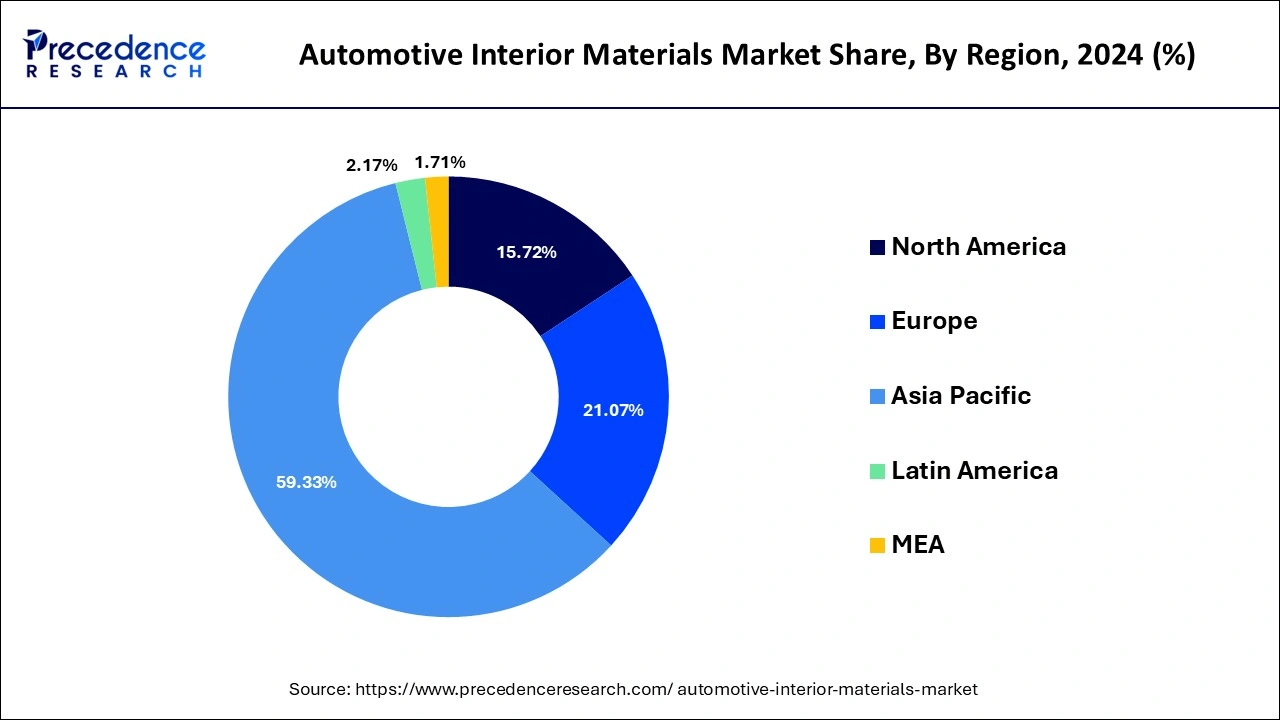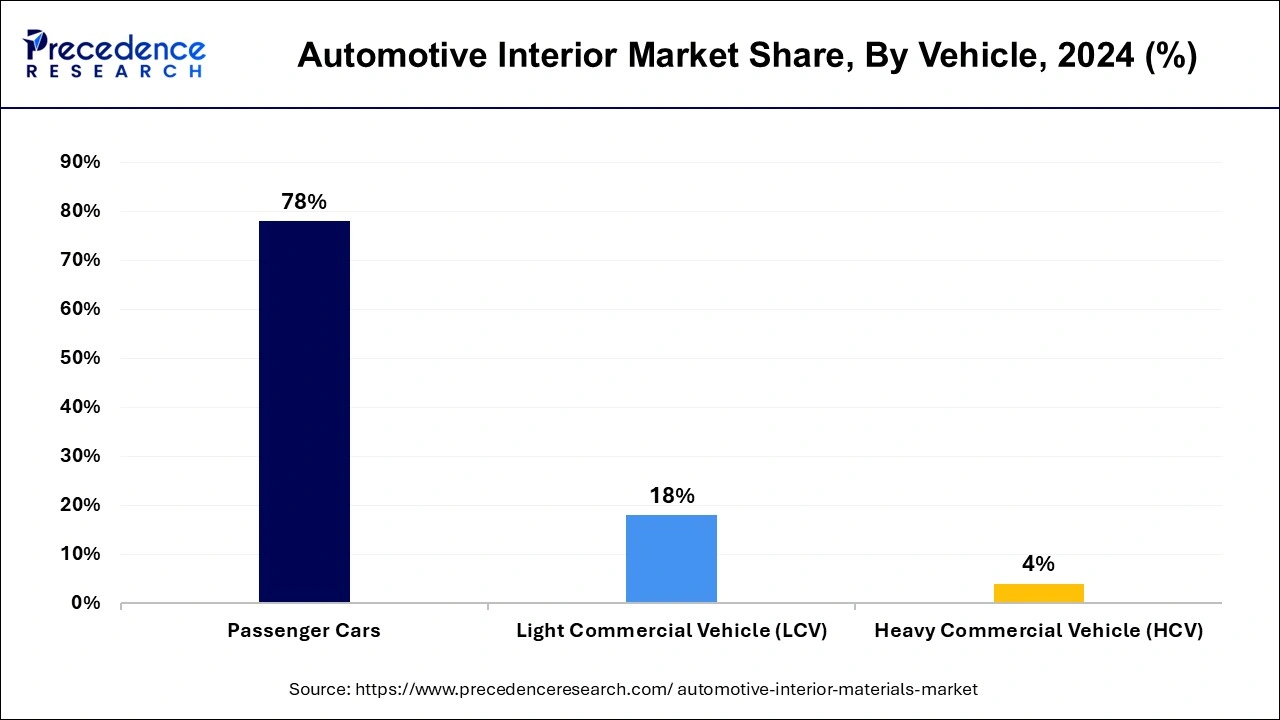January 2025
The global automotive interior materials market size is calculated at USD 65.73 billion in 2025 and is forecasted to reach around USD 92.98 billion by 2034, accelerating at a CAGR of 3.93% from 2025 to 2034. The Asia Pacific automotive interior materials market size surpassed USD 39 billion in 2025 and is expanding at a CAGR of 3.95% during the forecast period. The market sizing and forecasts are revenue-based (USD Million/Billion), with 2024 as the base year.
The global automotive interior materials market size was estimated at USD 63.24 billion in 2024 and is anticipated to reach around USD 92.98 billion by 2034, expanding at a CAGR of 3.93% from 2025 to 2034. The global automotive interior materials market growth is attributed to the increasing consumer preference for luxury and comfort features, stringent emissions regulations and increasing demand for lightweight vehicles.

AI is revolutionizing various aspects of the automotive industry, and automotive interior materials are no exception. AI has become an integral part of the automotive interior materials. AI enables the creation of personalized interior designs. AI can suggest interior layouts, colors, materials, and features that best suit the user, by analyzing driver’s biometric information, preferences and habits. For instance, BMW uses AI to adjust the cabin environment based on the driver’s previous preferences, including climate control settings and seat position. From voice-activated controls to AI-powered infotainment systems, AI is essential in integrating smart technologies into automotive interiors. These technologies enhance the driving experience and make the interior user-friendly and intuitive. These advanced AI trends are further expected to revolutionize the growth of the automotive interior materials market in the coming years.
The Asia Pacific automotive interior materials market size was evaluated at USD 37.52 billion in 2024 and is predicted to be worth around USD 55.21 billion by 2034, rising at a CAGR of 3.95% from 2025 to 2034.

Asia Pacific is dominated the automotive interior materials in 2024. The market growth in the region is attributed to the increasing urbanization, rising disposable income and rapid development of the economy.
China is the major and dominated country in the automotive interior materials industry. The increasing consumer preference in the aesthetic qualities of their vehicles is expected to drive the market growth in China. In addition, the increasing innovative interior designs of millennials and increasing demand from the target market, along with the increase in disposable income of the population are further anticipated to drive the growth of the automotive interior materials market in China.

North America is expected to grow fastest during the forecast period. The market growth in the region is attributed to the rising well-developed automotive industry and strong presence with key automotive manufacturers. The region estimated the rising demand for high-quality interior materials that balance durability, comfort and aesthetics. In addition, the strict safety regulations imposed by the adoption of advanced technologies further drives the market demand in North America.
The market growth in the U.S. is attributed to the increasing demand for attractive designs and better interiors with better features. In addition, the increasing presence of the latest and improved technologies and enhanced materials with the rising penetration of larger displays are further contributed to propel the growth of the automotive interior materials market in the U.S.
Automotive interior materials provide an appealing look, improved reliability, and enhanced sustainability for automobiles and hence help manufacturers to upgrade the vehicle performance and interior features. This also help automotive manufacturers in improving automotive cabin features and designs. Furthermore, increasing trend for electric vehicles and autonomous vehicles have prominently boosted the demand for light materials in an automobile. Autonomous and other advanced vehicles are equipped with several advanced technologies that requires multiple ECUs and chips to integrate into the vehicle this increases the overall weight of the vehicle as well as also triggers the need for light-weight materials for vehicle’s body and other parts.
The automotive interior materials are imperative to the vehicle manufacture. Thus, the dynamics of automotive interior materials market are closely dependent on the sale and production of vehicles. Further, the market growth for automotive interior materials is also dependent on the various government regulations for sales of vehicles as well as fuel efficiency. Apart from this, government regulation on leather pricing also plays a significant role in directing the global market value and trend. Internal substitution in the automotive parts particularly in case of leather likely to hamper the market growth. For instance, genuine leather is substituted by fabrics, synthetic PU, or PVC leather and thus the market for genuine leather is hampered in the automotive industry.
| Report Highlights | Details |
| Market Size in 2024 | USD 63.24 Billion |
| Market Size in 2025 | USD 65.73 Billion |
| Market Size by 2034 | USD 92.98 Billion |
| Growth Rate from 2025 to 2034 | CAGR 3.93% |
| Base Year | 2024 |
| Forecast Period | 2025 to 2034 |
| Segments Covered | Material, Vehicle, Application, End-User |
| Regions Covered | North America, Europe, Asia-Pacific, Latin America, and Middle East & Africa |
Passenger cars captured the largest revenue share of more than 78% in the year 2024 and projected to maintain the same trend over the forecast period. The growth of the segment is mainly attributed to the increasing sale of passenger vehicle coupled with introduction of autonomous and electric vehicles. Apart from above trends, the outbreak of COVID-19 has also played an important role in accelerating the sale of self-owned passenger cars in order to maintain the social distancing. This has impacted the growth of shared mobility, but proliferated the self-owned vehicle trend and hence triggered the sales of passenger cars.

On the other hand, the light commercial vehicles (LCVs) segment is projected to grow at a notable CAGR during the forecast period owing to rise in e-commerce and retail logistics particularly in the developing nations. The outbreak of corona virus has prominently uplifted the trend for online shopping rather than visiting shops. Hence, accelerated the markets for e-commerce and retail logistics and therefore supports the growth of light commercial vehicle market.
The material type segment is deviced into plastics, composites, leathers, fabrics and others. The plastics segment captured majority of revenue share in the year 2024 because of its favorable capabilities to make a vehicle lighter and more appealing in terms of aesthetics.
The Composite segment is projected to grow at a CAGR of 6% over the forecast period due to increasing demand for lightweight and fuel-efficient vehicles.
Seats application segment leads the global automotive interior materials market and accounted for more than 30% in terms of revenue share by the end of the analysis period. This is mainly because of the significant importance of seats for driver’s as well as passenger’s comfort and convenience. Different physiological and psychological studies on human perception, posture & adjustability, and weight distribution have resulted in the application of various materials for automotive seats. High performance PU foams along with covering materials that include fabric or leather are frequently used in seat cushion manufacturing. Increasing need for light weight materials in seats also trigger the application of carbon fibers and other composites to enhance the level of comfort in modern vehicles.
By Material Outlook
By Vehicle Outlook
By Application Outlook
By End-users Outlook
By Regional Outlook
North America
Europe
Asia Pacific
Rest of the World
For inquiries regarding discounts, bulk purchases, or customization requests, please contact us at sales@precedenceresearch.com
No cookie-cutter, only authentic analysis – take the 1st step to become a Precedence Research client
January 2025
April 2025
January 2024
January 2025